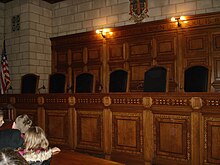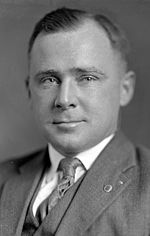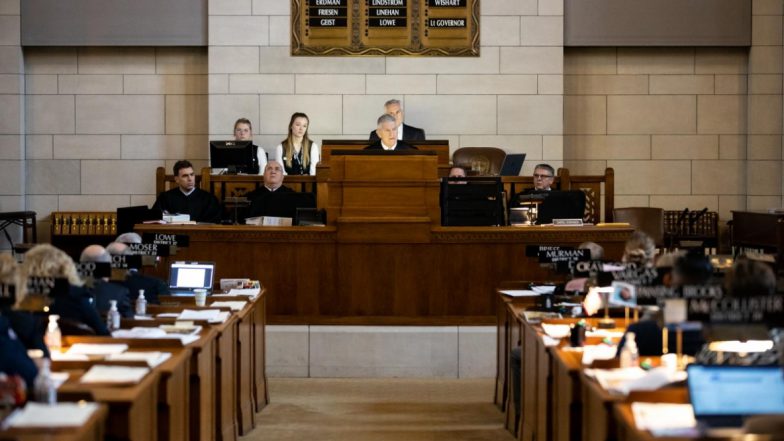Summary
The Nebraska Supreme Court is the highest court in the U.S. state of Nebraska. The court consists of a chief justice and six associate justices. Each justice is initially appointed by the governor of Nebraska; using the Missouri Plan, each justice is then subject to a retention vote for additional six-year terms. The six justices each represent a Supreme Court district; the chief justice is appointed (and retained) at-large.
Unlike most other states, with the exception of North Dakota, the Nebraska Supreme Court requires a supermajority of five justices of the seven to rule unconstitutional a legislative provision (the 48 others states require a simple majority).
OnAir Post: NE Judicial Branch
News
A man sentenced to death for the killing and dismemberment of a Lincoln woman he met on the date app Tinder will not get to serve as his own attorney in his automatic appeal.
The Nebraska Supreme Court last week rejected Aubrey Trail’s plan to fire his team of attorneys and represent himself in his appeal, the Omaha World-Herald reported. Trail, 55, had argued that his court-appointed attorneys have refused to support his request to sell some $25,000 in antiques and rare coins and give the money to a memorial fund set up for his victim, 24-year-old Sydney Loofe.
Trail and his girlfriend at the time of the killing, Bailey Boswell, already are under court order to pay $400,000 to a Kansas couple who fell victim to a rare coin scam pulled off by Trail and Boswell.
Trail was convicted in 2019 of first-degree murder and criminal conspiracy to commit murder in the 2017 murder of Loofe, whose body was cut into 14 pieces with the help of Boswell, wrapped in garbage bags and dumped in ditches along country roads in rural Clay County. Trail was sentenced to death earlier this year.
Boswell, 27, also was found guilty last year of first-degree murder and conspiracy to commit murder in Loofe’s death. She’s scheduled to learn on Nov. 8 whether she’ll be sentenced to death or life in prison.
Wikipedia
Contents

The Nebraska Supreme Court is the highest court in the U.S. state of Nebraska. The court consists of a chief justice and six associate justices. Each justice is initially appointed by the governor of Nebraska; using the Missouri Plan, each justice is then subject to a retention vote for additional six-year terms. The six associate justices each represent a Supreme Court district; the chief justice is appointed (and retained) at-large.
Unlike most other states, with the exception of North Dakota, the Nebraska Supreme Court requires a supermajority of five justices of the seven to rule unconstitutional a legislative provision (the 48 others states require a simple majority).[1]
The court’s justices
Selection of justices
The court consists of a chief justice and six associate justices. The six justices each represent a Supreme Court district. If a position becomes vacant, the judicial nominating commission, made up of four lawyers and four non-lawyers, holds a hearing to select potential candidates. The commission then submits two names to the Nebraska Governor, who then determines the replacing judge. If the Governor does not follow through with this responsibility within 60 days of receiving the nominees, the responsibility then goes to Chief Justice of the state Supreme Court. To retain the office, a judge must run in a retention election after serving three years. Additionally, the judge must run every six years to retain his seat. If the judge receives less than 50% of the affirmative vote, the judge is not retained. Nebraska judges do not have a mandatory retirement age, but they are granted retirement at age 65 or earlier, if it is due to disability.[2]
Districts
The Supreme Court of Nebraska is separated into six districts, with one Justice selected for each. Each justice faces a retention election from his or her district except for the Chief Justice, who faces a statewide retention election. The districts mostly follow county lines and are redrawn decennially after the census results are finalized. The 2021 redistricting produced the following districts:[3]
District 1
District 1 consists of Lancaster County.
District 2
District 2 consists of a part of Douglas County.
District 3
District 3 consists of Antelope, Boone, Boyd, Burt, Cedar, Cuming, Dakota, Dixon, Dodge, Holt, Knox, Madison, Pierce, Stanton, Thurston, Washington, Wayne, and Wheeler counties as well as parts of Douglas and Sarpy counties.
District 4
District 4 consists of parts of Douglas and Sarpy counties.
District 5
District 5 consists of Butler, Cass, Clay, Colfax, Fillmore, Gage, Hall, Hamilton, Jefferson, Johnson, Merrick, Nance, Nemaha, Nuckolls, Otoe, Pawnee, Platte, Polk, Richardson, Saline, Saunders, Seward, Thayer, Webster, and York counties.
District 6
District 6 consists of Adams, Arthur, Banner, Blaine, Box Butte, Brown, Buffalo, Chase, Cherry, Cheyenne, Custer, Dawes, Dawson, Deuel, Dundy, Franklin, Frontier, Furnas, Garden, Garfield, Greeley, Gosper, Grant, Harlan, Hayes, Hitchcock, Hooker, Howard, Kearney, Keith, Keya Paha, Kimball, Lincoln, Logan, Loup, McPherson, Morrill, Perkins, Phelps, Red Willow, Rock, Scotts Bluff, Sheridan, Sherman, Sioux, Thomas, and Valley counties.
Current justices
Current members of Nebraska Supreme Court are:
| District | Justice | Born | Joined | Term ends | Appointed by | Law school |
|---|---|---|---|---|---|---|
| Chief Justice | Michael Heavican | August 4, 1947 | October 2, 2006 | 2028 | Dave Heineman (R) | Nebraska |
| 1 | Stephanie F. Stacy | April 23, 1962 | September 28, 2015 | 2024 | Pete Ricketts (R) | Nebraska |
| 2 | Lindsey Miller-Lerman | July 30, 1947 | September 1, 1998 | 2026 | Ben Nelson (D) | Columbia |
| 3 | William B. Cassel | September 20, 1955 | April 26, 2012 | 2028 | Dave Heineman (R) | Nebraska |
| 4 | Jonathan Papik[4] | January 7, 1982 | May 7, 2018 | 2028 | Pete Ricketts (R) | Harvard |
| 5 | Jeffrey J. Funke | April 15, 1969 | June 27, 2016 | 2026 | Pete Ricketts (R) | Nebraska |
| 6 | John Freudenberg[5] | November 12, 1969 | July 6, 2018 | 2028 | Pete Ricketts (R) | Nebraska |
Chief justice
Mike Heavican is the Chief Justice of the Nebraska Supreme Court. He was appointed to the court by Governor Dave Heineman, a Republican, and assumed office as the court's presiding justice on October 2, 2006. He was retained in 2010, 2016, and 2022. The Chief Justice is appointed (and retained) at-large.
Salaries
As of January 2017, the Associate Justices and Chief Justice earn $171,975 annually. National Center for the State Courts, Salary Comparisons, Nebraska
History of the court

1850s to 1970s
Nebraska's original Supreme Court, referred to as the Territorial Supreme Court, was established following the Kansas–Nebraska Act in May 1854. Fifteen male judges comprised the bench of the Territorial Supreme Court. During the seventy-one years between 1867, when Nebraska became a state, to 1938 a total of thirty-seven judges sat on the Nebraska Supreme Court. The original total of a bench of fifteen was reduced to three. The three Supreme Court judges also served simultaneously as district court judges at the time of Nebraska's statehood. The Nebraska constitution was then amended in 1908 to include a bench of six associate justices and one chief justice. The chief justice position would be held by the justice with the least amount of time remaining in his term. The judges were originally chosen by partisan election. In 1908 this was later amended to a nonpartisan election. Currently the Nebraska Supreme Court justices are elected by way of a modified Missouri Plan.[6]
In the Nebraska Supreme Court's early years there were no regulations as to what cases could be appealed and heard by the court. Due to the lack of regulations the Supreme Court's docket became overloaded. As a solution the Nebraska Supreme Court was allowed to elect commissioners to assist with the workload. Originally three commissioners were elected, one from the Democratic Party, one from the Republican Party, and the last a member of the Populist Party. The three commissioners would serve a term of three years. In 1901 the commissioners numbers increased from three to a total of nine. Six of the nine commissioners would serve a one-year term and three would serve a two-year term. The commissioners sat in groups of three. This resulted in the creation of four appellate courts, the fourth being the Supreme Court. Select District Court justices were allowed to sit on cases heard by the Supreme Court under four stipulations found in Article V, Section 2 of the state's constitution. If the court was sitting in two separate five judge divisions, if the constitutionality of a statute was in question, an appeal case of a convicted homicide, and lastly when a decision by a division of the Nebraska Supreme Court was under review.[6] ) In 1977 a general guideline pertaining to the format of a court report was drafted and released to the court's reporters. This guideline would assure that all reports were structured in the same manner. Even with the efforts to increase the time efficiency of the Supreme Court the docket remained over filled. It was proposed to increase the existing bench of seven judges to a bench of nine. The amendment was opposed but revisited later in 1977. It was in this year that the Supreme Court Judges received a salary of 39,750 dollars, an increase from previous years.[7]
Boyd v. Nebraska ex Rel. Thayer
The case Boyd v. Nebraska ex Rel. Thayer was heard by the Supreme Court in 1891. The case was the result of a Gubernatorial Election in which Omaha Democrat James Boyd claimed victory. There were accusations by the Populist party regarding fraudulent votes in the favor of Boyd. John M. Thayer, the existing governor of the state, refused to give up his office. Thayer questioned the legitimacy of Boyd's citizenship claiming he was not eligible for office. Boyd's father, an immigrant, obtained citizenship after his son reached the age of majority. Thayer filed a quo warranto in the Nebraska Supreme Court. The court ruled that the father's citizenship did not apply to Boyd. The Nebraska Supreme Court restored Thayer to office. Boyd appealed after the ruling. The case progressed to the United States Supreme Court. The court ruled that Boyd was a citizen.[6]
Chief Justice Robert G. Simmons

Robert G. Simmons was the longest-serving chief justice in the history of the Nebraska Supreme Court as of 2024.[6] Chief Justice Simmons was born in Scotts Bluff County, Nebraska in 1891. He attended Hastings college and the University of Nebraska's College of Law. His early career paths included Scotts Bluff County Attorney, a lieutenant in the army, and was elected to congress as a Republican. On November 8, 1938 Simmons defeated former attorney general C.A. Sorenson and was elected Chief Justice of the Nebraska Supreme Court. The Simmons era heard several cases involving capital punishment. The court issued death warrants for four murders. The four death sentence's method was the electric chair. One of the four executions in the Simmons Era was Charles Starkweather. In 1951 the Simmon's court heard the case of Drabbels v. Skelly Oil Co. This case addressed the legitimacy of a murder charge in regard to an unborn child. The court unanimously ruled that a child who is still within the womb of the mother has no claim to life. Chief Justice Simmons retired on January 2, 1963 after serving on the bench for slightly over twenty five years.
Meyer v. Nebraska
Structure of the Nebraska courts
Decisions of the county court can be appealed to the district court, although some cases, such as probate cases and decisions of the county court sitting as a juvenile court, may be appealed directly to the Nebraska Court of Appeals. Decisions of the district court, juvenile courts, and workers' compensation court are appealable to the Court of Appeals. Decisions of the Court of Appeals are subject to further review by the Supreme Court.[8]
Notable cases
- Chicago B. & Q.R. Co. v. Krayenbuhl: Liability
- Gartrell v. Stafford: Breach of a contract
- Meyer v. Nebraska: Due process
- McGuire v. McGuire: Financial responsibilities in a marriage
- Nebraska Press Assn. v. Stuart: Free speech
- Stewart v. Heineman: Same-sex couples' right to become foster or adoptive parents
References
- ^ "Nebraska Keystone Ruling May Not Help Transcanada". Newsweek. 9 January 2015.
- ^ "Supreme Court of Nebraska Courts Guide".
- ^ "Supreme Court Judicial Districts - LB 6 (2021)" (PDF). Nebraska Legislature.
- ^ Pilger, Lori. "Ricketts' pick for Nebraska Supreme Court 'operating on higher level,' colleague says".
- ^ Johnson, Riley. "Newly appointed Lancaster County judge tapped for seat on Nebraska Supreme Court".
- ^ a b c d Hewitt, J (2007). Slipping Backward: A History of the Nebraska Supreme Court, University of Nebraska Press.
- ^ Dunlevey, J. E. (1976). "The Courts of Nebraska: A Report on Their Structure and Operation", Office of the State Court Administrator.
- ^ "The Nebraska State Judicial System | Nebraska Judicial Branch". Archived from the original on 2016-02-18.
External links
40°48′29″N 96°41′59″W / 40.808090°N 96.699587°W
- "Nebraska", Caselaw Access Project, Harvard Law School, OCLC 1078785565,
Court decisions freely available to the public online, in a consistent format, digitized from the collection of the Harvard Law Library



